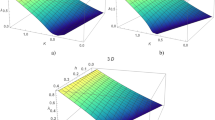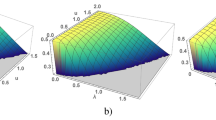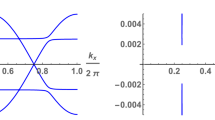Abstract
The Kondo insulator state (KIS) realized in the symmetric Anderson model at half filling is studied in the framework of a mean field approach. It is shown that the state of the Kondo insulator is realized in a lattice with a double cell and a gapped electron liquid behaves like a gapless Majorana spin liquid. The local moments of d-electrons form a static \(Z_2\)-field in which band electrons move. The gap value in the quasi-particle excitations spectrum decreases with increasing an external magnetic field and closes at its critical value. The behavior of an electron liquid is studied for an arbitrary dimension of the model. The proposed approach leads to the description of KIS without the need to resort to artificial symmetry breaking to alternative understanding of the physical nature of this phase state.
Similar content being viewed by others
Introduction
As a rule in the traditional interpretations of the Kondo lattice and Anderson lattice models interaction is decoupled in favour of a hybridization of electrons with different spins1,2. However, such an approximation breaks the local gauge symmetry: it does not conserve the spins of s- and d-electrons separately in the Anderson lattice, does not conserve the total number of band electrons in the Kondo lattice since the local d-occupation is no longer conserved. The effective Hamiltonian is obtained within a mean field approach, determines the ground state and low-energy quasi-particle excitations of the electron liquid. The effective Hamiltonian must have the same symmetry as the Hamiltonian of the model, otherwise the mean field approach can not be considered as adequate.
The Hamiltonian of the Anderson model has an exact solution when there is no hybridization between electrons or the Hubbard repulsion. Therefore, it is necessary to take into account both hybridization and repulsion between electrons for problem solving. This makes it possible to explicitly take into account the scattering of band electrons by local moments with spin flip. The Kondo effect in the Kondo problem and KIS in the Kondo lattice are realized to this scattering. In3 a compound \(FeSB_2\) as a candidate topological Kondo insulator based on 3d-electrons is investigated. The authors believe that insulator state similar to those in \(SmB_6\)4, \(YbB_{12}\)5 exist in the compound with \(d-\) instead of \(f-\)electrons also. The Anderson lattice model describes non topological KIS, so a traditional KIS will be studied.
The purpose of the paper is KIS realized in the symmetric Anderson lattice within the mean field approach without local gauge symmetry breaking of the model studying . A gapped electron liquid behaves like a gapless Majorana spin liquid in the Kitaev model6,7,8 in KIS. The local moments of d-electrons form a static \(Z_2\)-field in which band electrons move. A configuration of the \(Z_2\)-field corresponding to the ground state forms the lattice with a double cell and a global gauge symmetry is not broken.
Model
The Hamiltonian of the Anderson lattice is the sum of two terms, the first one determines the energies of s- and d-electrons and hybridization between them, the second one takes into account the on-site repulsion of d-electrons \({\mathscr {H}}={\mathscr {H}}_{0}+{\mathscr {H}}_{int}\)
where \(c^\dagger _{j,\sigma },c_{j,\sigma }\) and \(d^\dagger _{j,\sigma },d_{j,\sigma }\) (\(\sigma =\uparrow ,\downarrow )\) are the fermion operators determined at a lattice site j, U is the value of the on-site Hubbard interaction determined by the density operator \(n_{j,\sigma }=d^\dagger _{j,\sigma }d_{j,\sigma }\), the band width of s-electrons is determined by the hopping integral equal to unity, the energy of flat band of d-electrons is equal to \(\varepsilon _g\), v determines the hybridization of s- and d-electrons, H is an external magnetic field, N is the total number of atoms.
(Color online) A local moment of d-electrons \(m=\frac{1}{2N}\sum _{{\textbf {k}}}(n_{{\textbf {k}},\uparrow }-n_{{\textbf {k}},\downarrow })\) as a function of \(\lambda , v\), calculated for \(v<2\sqrt{2} \lambda\) for a square lattice at half filled occupation, a value of a local moment changes from \(\frac{1}{2}\) at \(v=0\) to \(\frac{1}{6}\) at \(v\rightarrow \infty\).
The electron liquid behavior in the Kondo problem and the Anderson model is universal in the sense that it does not depend on the dimension of the system and their exact solutions do not depend on dimension of the models9,10. We will show that this universality is preserved for the symmetric Anderson lattice model, as it was noted at first in2. According to Wiegmann9,10 the Kondo regime is realized in the symmetric Anderson model in the integer valence state at \(\rho v^2< -\varepsilon _g\) (where \(\rho\) is the density states of s-electrons at the Fermi energy). We will consider the symmetric Anderson lattice defined on the chain and simple square and cubic lattices.
Effective Hamiltonian of the symmetric Anderson model in the Kondo insulator state
Using \(n^2_{{\textbf {j}},\sigma }=n_{{\textbf {j}},\sigma }\) we redefine the interaction term in the Hamiltonian (1) \({\mathscr {H}}_{int}= -\frac{1}{2}U\sum _{\textbf {j}}(n_{{\textbf {j}},\uparrow }-n_{{\textbf {j}},\downarrow })^2\). The Hubbard-Stratonovich transformation converts the problem with interaction into a non-interacting one in a stochastic field (hereinafter we will define as the \(\lambda\)-field). We define the interaction term, taking into account the action \({S}_{0}\), defining the noninteracting terms in the Hamiltonian
The canonical functional is defined as
where the action \(S=\frac{2}{U}\sum _{{\textbf {j}}}\lambda ^2_{{\textbf {j}}}+ \int _0^\beta d\tau \Psi ^\dagger (\tau )\left[ \partial _\tau + {\mathscr {H}}_{eff}\right] \Psi (\tau )\), \(\Psi (\tau )\) is the wave function, \(\beta = \frac{1}{T}\), here T is the temperature. Taking into account (2) we introduce an effective Hamiltonian \({\mathscr {H}}_{eff}={\mathscr {H}}_0 + 2\sum _{{\textbf {j}}}\lambda _{{\textbf {j}}}\left( n_{{\textbf {j}},\uparrow }- n_{{\textbf {j}},\downarrow }\right)\) corresponding to this action. The translation invariance is conserved in an electron liquid state and as a result the value of \(\lambda _{{\textbf {j}}}\) does not depend on \(\tau\).
The effective Hamiltonian includes the \(Z_2\)-field, associated with \(\lambda _{\textbf {j}}\), where \(\lambda _{\textbf {j}}\) could have two values \(\pm \lambda\) at each lattice site. The energies of the d-electrons located at lattice site \({\textbf {j}}\) are equal to \(-2\lambda _{\textbf {j}}\) and \(2\lambda _{\textbf {j}}\). In this case, the local moment of the d-electron at each lattice site is not fixed, therefore s-electrons are hybridizes with d-electrons located randomly along the spin. According to Lieb11 a free configuration of a static \(Z_2\)-field corresponds to the energy minimum as a rule. A numerical calculations of the energy of the Hamiltonian \({\mathscr {H}}_{eff}\) showed that the nontrivial uniform configuration of the \(Z_2\)-field corresponds to the energy minimum, a namely for \(\lambda _{\textbf {j}}=\lambda\), \(\lambda _{{\textbf {j+1}}}=-\,\lambda\). This uniform configuration forms the lattice with a double cell at \(\lambda \ne 0\) .
The action S is integrated out the fermion operators obtaining
where \(\omega _n =T(2n+1)\pi\) are the Matsubara frequencies and eight branches quasi-particle excitations \(\varepsilon _\gamma ({\textbf {k}})\) (\(\gamma =1,\ldots ,8\)) determine the electron states in an external magnetic field.
In the symmetric Anderson lattice describing by the effective Hamiltonian \({\mathscr {H} }_{eff}\) for \(\varepsilon _g=-\frac{U}{2}\), the local density of d-electrons constrain \(n_{{\textbf {k}},\uparrow }+n_{{\textbf {k}},\downarrow }=1\) is valid in KIS for an arbitrary value of the wave vector \({\textbf {k}}\) and arbitrary parameters of the Hamiltonian (1), where \(n_{{\textbf {k}},\sigma }=\frac{1}{N}\sum _{{\textbf {j}}} n_{{\textbf {j}},\sigma }\exp (i {\textbf {k}}{} {\textbf {j}})\). It is reduced to a local condition \(n_{{\textbf {j}},\uparrow }+n_{{\textbf {j}},\downarrow }=1\), necessary for transformation of the local spin-\(\frac{1}{2}\) operator via the d-electron operators.
The ground-state
In the absence of an external magnetic field, the spectrum of quasi-particle excitations is doubly degenerated in spin \(\varepsilon _\gamma ({\textbf {k}})=\pm E_\pm ({\textbf {k)}}\) (\(\gamma =1,\ldots ,4\))
where \(w({\textbf {k}})=\sum ^D(1+\exp (i k_\alpha ))\), \({\textbf {k}}=(k_x,k_y,k_z)\) is the wave vector.
An external magnetic field shifts the branches of quasi-particle excitations and breaks the degeneracy of the spectrum, the spectrum splits into eight branches of quasi-particle excitations \(\varepsilon _\gamma ({\textbf {k}})=\pm H \pm E_\pm ({\textbf {k)}}\) (\(\gamma =1,\ldots ,8\)). At half filled occupation, the electron spectrum is symmetric with respect to zero energy and it is doubly degenerated in spin at \(H=0\) (4). The electron spectrum consists of eight branches of quasi-particle excitations. The chemical potential is equal to zero. For \(v,\lambda \ne 0\) it is gapped, the gap opens at \({\textbf {k}}=0\) for \(v>2\sqrt{2}\lambda\) or at \({\textbf {k}}=\overrightarrow{\pi }\) for \(v <2\sqrt{2}\lambda\). The first case corresponds to intermediate valence regime of local d-states. We consider the case \(v<2\sqrt{2}\lambda\), in which a local moment \(m=\frac{1}{2N}\sum _{{\textbf {k}}}\left( n_{{\textbf {k}},\uparrow }-n_{{\textbf {k}},\downarrow }\right)\) is changed in the interval \([\frac{1}{6},\frac{1}{2}]\), where \(m =\frac{1}{2}\) for \(v=0\) and \(m=\frac{1}{6}\) for \(v\rightarrow \infty\).
KIS arises as a result of flip up spin scattering of s-electrons on the local moments. The condition for the realization of such phase state is considered in the symmetric Anderson lattice . The local moments of d-electrons are realized for integer valence state at \(v<2\sqrt{2}\lambda\) for arbitrary values of v and \(\lambda\). The result of numerical calculation m for a square lattice is shown in Fig. 1. The behavior of m has an universal form for different dimensions in the coordinates \((\lambda ,v)\) (the surface in Fig. 1 is slightly deformed in different dimensions). The small value of m corresponds to the absence of local moments in the intermediate valence of d-states. The value of the gap is an universal function of \(v, \lambda\) for arbitrary dimension2 and is equal to \(\Delta (H)= \Delta (0)-2H, \Delta (0)=2(-\lambda +\sqrt{\lambda ^2 + v^2})\), in the weak v-limit \(\Delta (0) \simeq \frac{v^2}{\lambda }\).
In the magnetic field \(H<H_c=\frac{1}{2}\Delta (0)\) the phase state of the electron liquid with \(\sum _j<c^\dagger _{j,\uparrow } c_{j,\uparrow }>=\sum _j<c^\dagger _{j,\downarrow } c_{j,\downarrow }>\) is gapped and the ground state energy does not depend on the magnetic field. In saddle point approximation a magnitude of the \(\lambda\)-field does not depend on the magnetic field, in the ground state the self-consistent equation has the following form
The self-consistent equation makes it possible to determine the magnitude of the \(\lambda\)-field depending on the parameters of the model Hamiltonian (1) v and U. The calculations of \(\Delta (0)\) are shown in the coordinates U, v for different dimensions of the model in Fig. 2. According to the numerical calculations the value of \(\Delta (0)\) changes slightly whith the model dimension changing.
An external magnetic field breaks the spectrum degeneracy causing the spectrum splitting into eight branches of quasi-particle excitations. The value of gap decreases with increasing magnetic field and the gap closes at a critical value \(H_c\). The spectra of the quasi-particle excitations of an electron liquid calculated for the chain and square lattice correspondingly (where at \(H=0\) \(\Delta =0.1656\) and at \(H_c=0.0828\) \(\Delta =0\)) are shown in Figs. 3 and 4. The effect of magnetic field on the phase state of the electron liquid is reduced to a decrease in the gap. For \(H>H_c\) the quasi-particle spectrum is gapless and KIS disappears. The behavior of electron liquid in the small magnetic fields \(H<H_c\) at which KIS realized is studied. The nature of the Kondo insulator and topological KISs is similar and the topological states define the surface properties of compounds while the bulk their properties are the same usually.
Conclusion
The symmetric Anderson lattice at half-filling for different dimensions is studied. We propose a new physical mechanism for the formation of KIS using the mean field approach . The behavior of electron liquid in KIS is similar to the Majorana spin liquid behavior in the Kitaev model. The local moments of d-electrons form a static \(Z_2\)-field in symmetric Anderson lattice where band electrons move. At half filled occupation the ground state configuration of this field corresponds to the lattice with a double cell. In contrast to the gapless Majorana spin liquid, an electron liquid in KIS is gapped. The scattering of band electrons on d-electrons depends on their spins In the Kondo problem and the spin flip scattering dominates and forms the Abrikosov-Suhl resonance. Due to a static \(Z_2\)-field s-electrons hybridize with d-electrons with energies determined by the field. This one-particle consideration makes it possible to take into account the interaction between \(s-\) and \(d-\)electrons in the framework the Hamiltonian that does not break the symmetry of the model for arbitrary dimension.
In one-particle effective Hamiltonian s- and d-electrons are hybridized with the same spins, in this case, a static \(Z_2\)-field changes the energies of the local d-states with which the band electrons are hybridized. Thus, the band electrons are hybridized successively with different local d-states. In the symmetric Anderson model at half filling, the spectrum of quasi-particle excitations is symmetric with respect to zero energy, it is similar to Majorana’s spectrum. The value of the gap is determined by both v and U and the gap protects KIS. There is a critical value of the magnetic field at which the gap closes and this way a phase state is destroyed.
Data availability
All data generated or analysed during this study are included in this published article.
References
Coleman, P. & Andrei, N. Kondo-stabilised spin liquids and heavy fermion superconductivity. J. Phys.: Condens. Matter. 1, 4057 (1989).
Karnaukhov, I.N. Electron liquid state in the symmetric Anderson lattice. Sci. Rep. 11, 5842 (2021).
Xu, K.-J., Chen, S.D., He, Y., & Shen, Z.-X. Metallic surface states in a correlated 4d-electron topological Kondo insulator candidate \(FeSB_2\). Appl. Phys. Sci. 117, 15409 (2020).
Takimoto, T. \(SmB_6\) A promosing candidate for topological insulator. J. Phys. Soc. Jpn. 80, 123710 (2011).
Hagiwara, K. Surface Kondo effect and non-trivial metallic state of the Kondo insulator \(YbB_{12}\). Nat. Commun. 7, 12690 (2016).
Kitaev, A.Y. Anyons in an exactly solved model and beyond. Ann. Phys. 321, 2 (2006).
Karnaukhov, I.N. Mott-Hubbard phase transition, gapped electron liquid in insulator state (2020). arXiv:2205.11950
Karnaukhov, I.N. Electron liquid state in the spin-1/2 anisotropic Kondo lattice. Sci. Rep. 12, 7420 (2022).
Wiegmann, P.B. Exact results in the theory of magnetic alloys. Pisma Zh. Eksp. Teor. Fiz. 31, 391 (1980).
Wiegmann, P.B. Towards an exact solution of the Anderson model. Phys. Lett. A 80, 163 (1980).
Lieb, R.H. Flux phase of the half-filled band. Phys. Rev. Lett. 73, 2158–2161 (1994).
Acknowledgements
The work was supported by the program competition theme “Physical development of materials for elastic-caloric cooling (ELAST)” No 0122U001169 . The author thanks to Springer Nature waivers team for support of open access publication of the paper.
Author information
Authors and Affiliations
Contributions
I.K. is an author of the manuscript.
Corresponding author
Ethics declarations
Competing interests
The author declares no competing interests.
Additional information
Publisher's note
Springer Nature remains neutral with regard to jurisdictional claims in published maps and institutional affiliations.
Rights and permissions
Open Access This article is licensed under a Creative Commons Attribution 4.0 International License, which permits use, sharing, adaptation, distribution and reproduction in any medium or format, as long as you give appropriate credit to the original author(s) and the source, provide a link to the Creative Commons licence, and indicate if changes were made. The images or other third party material in this article are included in the article's Creative Commons licence, unless indicated otherwise in a credit line to the material. If material is not included in the article's Creative Commons licence and your intended use is not permitted by statutory regulation or exceeds the permitted use, you will need to obtain permission directly from the copyright holder. To view a copy of this licence, visit http://creativecommons.org/licenses/by/4.0/.
About this article
Cite this article
Karnaukhov, I.N. Gapped electron liquid state in the symmetric Anderson lattice, Kondo insulator state. Sci Rep 12, 18607 (2022). https://doi.org/10.1038/s41598-022-23221-w
Received:
Accepted:
Published:
DOI: https://doi.org/10.1038/s41598-022-23221-w
This article is cited by
-
The ground state of the Kondo insulator
Scientific Reports (2023)
Comments
By submitting a comment you agree to abide by our Terms and Community Guidelines. If you find something abusive or that does not comply with our terms or guidelines please flag it as inappropriate.







